
HERE I STAND, holding a hose, happy to have fresh water at my fingertips. A landscape truck passes by, jingling with irrigation parts. My neighbor has just updated his watering system. It twirls and streams as the water runs off into a drain, none of it absorbed by the already soaked soil. The system he has installed has complete coverage; it is programmed to turn itself on and off with a timer—no one has to do a thing. I imagine him looking at me and thinking: “What kind of an unsophisticated, homespun garden is that—that guy couldn’t even put in a proper irrigation system!” As I happily work out a kink in my hose, I think to myself, “If I had such boring plants, maybe I’d want to hide them in a cloud of water, too.”
Watering takes time; it requires critical skills. Many of us remember our grandparents standing in the yard with a hose. We may not have noticed then, but they weren’t just squirting it willy-nilly; there was a method to it. They dragged the hose around and aimed it at plants that needed a certain amount of water, at a specific time of day, in the right season. They would single out and address plants that needed water, even while they were sitting right next to plants that didn’t. They were using their watering skills. It’s time to give those skills their due respect.
Seeds of many old-fashioned annuals, such as this pink petunia, will rot under constant irrigation. The exuberance and success of this garden comes from restraint, from not having an irrigation system.
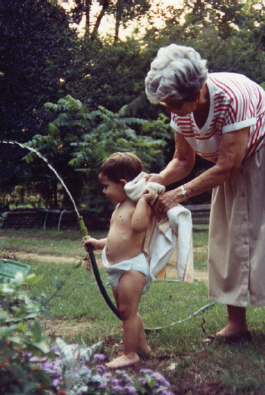
My grandmother and nephew, sharing the joy and skills of using a hose.
One-size-fits-all watering systems don’t address all issues, and at their worst they can create new problems. Poorly used and installed, they’re incredibly wasteful, they drown plants, and they create a sense that everything is taken care of, that you don’t need to be involved. They sabotage our watering skills and erode our understanding of plants as part of a larger system. We expect expensive systems to make gardening easier and better. We bought them thinking that they’d make our lives more carefree. In the end, they end up controlling us in ways we don’t even realize. It’s a mistake to think that any automated system can wholly replace watering skills. There are certainly fantastic systems, and they are getting better all the time, but over all, rather than improve watering methods, the influence and popularity of automatic systems has slowly started to alter gardening techniques and even had an effect on the selection of plants that are available in nurseries. Whether it’s conscious or not, we’ve begun to select plants that thrive or tolerate frequent sprays of water on their leaves or on saturated soils. Other plants have been edged out and forgotten.
These systems are still very new. The idea that millions of small homes and businesses should have plastic pipe running around and under the lawns, spraying plants, benches, and parking areas with a fine mist of clean water—even when it’s raining—is a very recent development. It wasn’t until the 1960s, when the increased availability of affordable PVC piping allowed us to install irrigation systems.
Sure, there were irrigated gardens before that. For example, Smiley Burnside was a doctor and a gentleman of the old school. Competitive in the camellia world, he grafted, selected, and entered his flowers in camellia shows around the South. A successful man, Smiley had the resources to hire an English garden designer and to install an irrigation system in the 1940s. It was still there, in the 1990s, when I restored his gardens and wrestled that system. It was like a living thing; a helicopter-like pump sat at the edge of his lake slurping up water. An industrial-sized startup switch in the basement of another building activated miles of galvanized pipe that throbbed and thumped with primal power pushing water up a hill and across 8 acres. It was extravagant for the time, but it wasn’t automatic. Even then, with a brand new, state-of-the-art system, Smiley knew you applied water only as needed.
In another more recent example, on a plantation garden near Charleston, South Carolina, a huge percentage of the antique rose collection was wiped out in a matter of months. As the plants declined, the owners watered more. No one bothered to discover that the irrigation system had overdrawn the well. The system was pulling salt water from the nearby marsh. As it watered more and more, it killed the garden. Even during the crisis, the owners wouldn’t acknowledge that their irrigation system had delivered the toxins. Finally, plant pathologist and sleuth Kari Whatley, of PlantScout, stated the problem simply: “Overconfidence in the technology and lack of detailed observation combined to allow the irrigation system to constantly deliver contaminated water to the plants.” The same can be said of many civilizations, which crumbled because they failed to understand water.
Before I was even aware that some people could afford such extravagances, I watered with my family—my teachers—the same way everyone else watered. We used repaired hoses that kinked or were 10 feet too short; we used buckets that were always in the wrong place. Even old leaky pots and plastic milk jugs that soaked our feet helped us get water where it was needed. Ironically, the house and garden where I grew up were previously fed by a ram. A ram is a very clever, self-powered device that uses the kinetic energy of flowing water to pump a small stream of water a long way. Rams were used in Egypt to move water to the top of the pyramids; they’re used today because they’re easy to make and they pump water for free. In the nearby swamp, a half-mile away and 100 feet below, remnants of the ram walls and bits of pipe leading to the house still remain. I’d love to put it back together, but it would cost too much in time and money.
I grew up with the understanding that water is precious and needs to be applied to plants at specific times and when certain signs from the plant and the soil communicate to you that it’s needed. In the gardens I’ve established in my professional work, some had irrigation and some did not. Riverbanks Botanical Garden had an expensive system that we scrapped in the first year. Today, the garden does have an amended, simpler system of irrigation. But this, like any great garden, is not subjugated by automation. Successful gardens depend on clean water provided to plants when they need it, by people who understand and embrace the relationships between plants, soil, air, and water.
The Teachers
RYAN GAINEY AND JIM MARTIN
There is a primal pleasure in touching water. I’ve met so many gardeners who tell me that their favorite thing to do in the garden is water. They’ll tell me how much they love to water their rosemary, or stick a hose pipe in the dirt, or use their special galvanized buckets. Watering is nurturing, relaxing, and engaging all at once. Ryan Gainey and Jim Martin, two important men in my life who’ve encouraged and supported me in different ways, value the skills and pleasures of hand watering.
Ryan Gainey is an internationally recognized garden designer. His long career involved commutes on the Concorde to design glamour gardens in Europe and across the United States. He was featured in Audrey Hepburn’s acclaimed PBS series Gardens of the World, and in projects with Atlanta’s High Museum of Art. Despite working at these lofty heights, Ryan told me, “I grew up in the country. Poor. The women who taught me to garden—honestly, their names were Miss Flowers, Miss Fowler, and Miss Fells—watered everything with buckets and long-handled dippers and always in the morning, after breakfast chores were done.” Ryan is proud of the people and places where he grew up—rural, poor, and sharecropping tobacco farms outside Hartsville, South Carolina. He embraces the styles and lessons he learned from these country gardeners.
Ryan Gainey waters his garden by hand, but he takes off his rings before doing so.
Today, in his celebrated Decatur, Georgia, garden, which has been featured on the cover of House and Garden and was a set for a Disney movie, Ryan still waters with watering cans. As you enter, the old, galvanized tin cans sit atop a stone wall. They make a cute and quaint display, and they are regularly put to work. This stunning garden is watered by rain, by hose, and by those watering cans that sit front and center, just inside the garden gate. That’s where they are handy. And that’s where they make a statement: this is a handmade garden.
Ryan says that subordination to automation can kill some plants by drowning them, causes foliage issues, and promotes soil-borne pathogens that wouldn’t be able to thrive without the constant water. Ryan, who has rooted miles of boxwoods, once told me, “Never irrigate boxwoods; it will kill them.” I’d have to counter that irrigation doesn’t exactly kill boxwoods, but overwatering encourages pathogens in the soil that can kill them. In a client’s garden, I struggled with a sad hedge of boxwoods for years. The problem was rooted in the client’s desire to locate this hedge around a lawn. The soil was sticky clay, and the lawn’s irrigation systems kept everything very wet. The American boxwoods died. Eventually, I replaced them with Korean ‘Wintergreen’ boxwood, which can tolerate wet soils better than any other. The substitution worked, but this illustrates how plant selection was dictated by an overused irrigation system. The better solution would have been to simply choose something different from a constantly perfect, thirsty, putting-green lawn paired with a hedge that likes to be a bit dry.
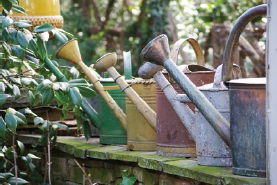
Ryan Gainey’s watering cans sit by the edge of a fish fountain where they are easy to fill and use in his hand-watered garden.
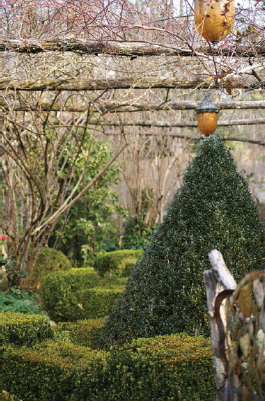
Ryan Gainey’s famed Decatur, Georgia, garden relies on the structure of boxwoods, a plant he says should never be under irrigation.
Ryan’s garden is built on the ruins of a 1920s nursery and greenhouse. He has photos and records of the operation showing containers everywhere, which was common in early nurseries. We can learn from this. In the time before plastic nursery pots, plants were mostly grown in the ground and sold bare root or later in various pots made of materials such as metal or clay. Clay pots were heavy and messy; they didn’t lend themselves to the kind of cash-and-carry nurseries we have today. Even though we don’t use clay pots in nurseries anymore, they can add a rustic, earthy feel to gardens and on patios, and plants love them. Understanding the way water and plants relate to clay helps your plants thrive. Clay loses water through every pore. One way to reduce this, in periods of drought, is to plunge the entire pot into the ground. In old nurseries and greenhouses, including the former occupant of Ryan’s garden, there were special plunge beds for this. Those beds were filled with leaf litter or ground bark that retained water in summer and provided insulation. Ryan offers a tip for watching moisture levels: “Know the ring, the tone, the sound of terracotta. Thump a pot and listen. Solid sound means the soil has moisture, while a dry ring means it’s time to water.” So the sound of and the look of a clay pot is a way to read the moisture content of the soil. A modern nursery manager told me he could do this with plastic, but I could never get a handle on the tones.
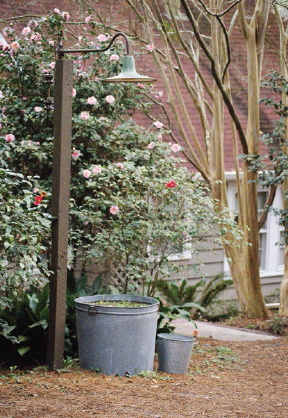
Old, galvanized nursery containers used as front-door planters.
There was a time of transition when people grew in repurposed tin cans. And you still can, if you so desire. If you punch a hole in a tin can, it makes a cute, recycled pot. But be warned, water rusts metal. In my experience, it just takes a year to rot a coffee can. You can slow this by choosing low-water plants, such as agaves or succulents. It’s also a good idea to place the cans on decks or patios. When set on the ground, the roots will grow through—not only your water holes, but weak spots in the metal—and start growing in the ground. Ever picked up a plant in a tin can, only to leave the plants, roots, and soil behind, all perfectly formed by the can?
For many of the reasons described here, tin and clay were both seen as having inherent problems. So they mostly went away, along with some of the skills and understanding we gained from working with them, and were replaced by the versatile, malleable, and ubiquitous black plastic pots.

“Know the ring, the tone, the sound of terracotta.” In old nurseries, there were often special beds for sinking clay pots in rich, moist soils.
No matter what kind of pot you use, the old greenhouse practice of sinking pots works at home, too. Since most of us gardeners have little holding areas, places we keep plants in pots, an easy way to reduce water needs is to sink them, just as they did in the floral nursery that Ryan’s garden was built on. In my own holding area, I use a variation on this. I dug holes for several empty containers and installed them in the ground. Those containers act as receptacles, or sleeves, where I can slide other potted plants into them for holding. Since they’re insulated in the ground, moisture stays in the pot longer, and the plant doesn’t have to be watered daily. It also helps the plant to stand up better, propped up by the sleeve. Many large nurseries have entire fields managed this way, known as a pot-in-pot system.
The most important thing to remember is that your plants’ watering needs often change depending on what type of pot you’re using. And watering all those pots and plants can be a lot of work. Ryan has an occasional helper and the resources to pay someone—a knowledgeable someone—to water when he’s away. The rest of us just have to do the best we can within our budgets. In our garden, I have dozens of metal, plastic, and clay pots that need regular attention, but I don’t have the resources to hire additional help. Fortunately, I’m lucky enough to be able to ask my mother to do it. I also group my pots and set up a temporary hose and timer to water while I’m away. But I can see the difference when I get back and return to watering by hand. The little droplets of water from the sprinkler, no matter how long it runs, won’t all find their way into the soil. No matter what type of pot you choose, or whether or not you have a helper or a timer or an entire system, when you’re available to do it, nothing satisfies your plants’ water needs like doing it by hand.
You can have a great garden without an irrigation system. Plants can thrive. It’s good for the garden, and it can be good for you, too. Time spent watering is your meditation time, a time for learning and observing. It keeps you close to the ground, and closer to your plants and their world. But you have to cultivate good watering and observation skills to succeed. And Jim Martin has spent his career showing thousands of people how to do just that.
Jim Martin lets his time spent doing hands-on work become his meditation; it’s his chance to be absorbed into his garden.
Jim Martin is a professional horticulturist and farmer, and a really busy man. He’s been director of the three major botanical gardens in South Carolina, and he’s in charge of the plantings in all of Charleston’s public parks. In each, he simultaneously planted, designed, budgeted, raised the funds, and set strategic plans. His powder-blue van, wrapped in a giant sticker that reads, “Compost in My Shoe,” is always full of projects, and even a few changes of clothes. He runs an organic farm, a specialty produce business, and keeps bees and a killer home garden. You’d think an irrigation system would save him time. But he, too, does it by hand: “There are many days I come home so tired or bothered and tempted to do nothing. But I see the garden needs water, so I have to do it, and whoosh, I’m absorbed in the garden.” Absorbed; connected; communicating with his living plants. Jim asserts:
I think one of the biggest problems with an irrigation system is that it takes you away from a very intimate, critically important task of gardening. On my farm, I do use drip irrigation, but in my garden, I hand water only. It’s my motivator. I have to do it, I love to do it, and I don’t see it as a chore. Things are happening that I need to see. When I water, I’m watching what’s going on.
Watering by hand helps focus attention. You see things, smell things, and understand the world that exists inside your perennial border.

Hymenocallis, also called spider lily, thrive in places that are alternately flooded and bone dry.
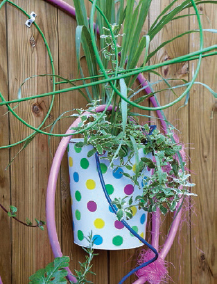
Jim grows vegetables and herbs in a vertical garden watered with a creatively painted drip system.
Another way Jim deals with his watering needs is simply by learning more about his plants and how they adapt to and tolerate stress, and then planting things accordingly. Under the live oak, for example, he has tough shade plants like bromeliads and dwarf palms and intricate trellises holding container plants. In a ditch out front, which floods in big rains, he grows Hymenocallis bulbs, around here called Fourth of July lilies, which are riverine bulbs from areas that flood seasonally. Lately, this has been known as hydrozone gardening; simply put, pick the right plant for the right place. Jim adds that we also have to understand that many plants tolerate drought stress just fine, even if they wilt. By way of example he tells me, “You wouldn’t believe how tough autumn fern is. I have entire sections full of the plants that can tolerate stress, so in a bad summer, I let them go. You know, even grass can go dormant in the summer. It comes right back.”
Still, for all the condemnations I’ve made of irrigation systems, the truth is that the systems themselves are only part of the problem. We install technology that’s billed as something to help us garden better, then we let it drown our plants, waste our water, and cause us endless frustration. We know this; we watch it happen, yet we still leave them running. But technology can yet have its place in the garden. New types of systems have evolved toward efficiency in water use and installation. Jim says:
Drip and surface are great, but overhead usually wastes too much and causes problems. I do use drip on some of my vegetable farms out on other islands. Things happen and I might not get out to those fields for a few days. But when I’m around, I hand water. Even among small-scale, organic farmers, there’s this groupthink that we must irrigate, we must drip, we mustn’t waste water with a hose. I water to my plants’ needs—even in a row of eighty-five chards, I know which ones will dry out first due to some soil changes.
Jim is fascinated with epiphytes—plants like some bromeliads, orchids, and cacti that grow without soil—and vertical gardening. He’s constantly testing wooly pockets, shopping carts, and anything that can be hung onto walls or from trees. His quest: make fun planters and pair them with plants that thrive in the material that they’re made of—clay, metal, plastic, mesh, or synthetic macramé with appliqués on it. Since the drip system is a necessary part of that, he makes his fun and funky. His drip hose is painted pink and pinned to the wall in spaghetti swirls, and the tiny purple emitter hose spirals out toward the hanging plants. If he has time, he color coordinates the planting and painting of the tubes. Still, he turns the system on as needed.
But for the bulk of his garden, Jim uses his watering skills, his observation skills, and his understanding of the ways that plants respond to their environment. Most automatic irrigation systems put you in the position of relying on a general system to do precise work, preventing you from making careful observation of the plant’s needs. One size does not fit all. Different plants have different needs, and even the same plant has different needs on different days.

This coleus has closed its stomata to prevent water loss during the hottest part of the day. It does not need extra water.
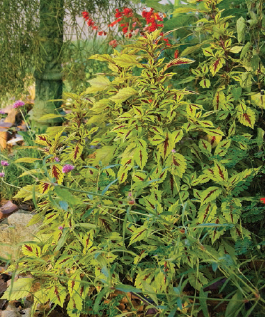
Since all conditions were normal, the same coleus, without any additional water, has rehydrated during the night.
Updates and Adaptations
The ability to observe the telltale signs of plant water stress is a skill that makes a great gardener—and a great nursery manager. In our field nursery and in the gardens and landscapes that I plan, people often question the lack of complex irrigation systems. I tell them that we can and sometimes do irrigate mechanically, but we ask broader questions. We use an array of skills and techniques dictated by what plants need. The success and validity of our philosophy and practice is easy to see in our field nursery and in gardens we manage for others.
We water our nursery plants to encourage a healthy growth rate, produce healthy plants, and conserve water and the energy needed to pump that water from 350 feet belowground. To be clear, that’s different from the goals of most irrigation systems, especially in nurseries, where the goal is to produce maximum growth in minimum time. Our plant products—crinum bulbs—like most living things, are mostly water. I could produce a fat, plump bulb more quickly with constant, intensive irrigation. But that bulb would just be water. Instead, the bulbs we produce are dense and packed with carbohydrates; they’re more resilient, and perform more successfully in our customers’ gardens.
When considering new plants, consider the water needs of that plant and, just as important, how that specific plant was grown. Plants grown in nurseries with constant irrigation need more water in the transition to the ground than plants grown in drier conditions. We grow our plants in the ground so that they have access to normal soil and soil water. We’ve tried various systems. Because of their wastefulness, one-time-use drip tubes, which are tilled up or thrown away each year, do not interest me. Instead, we use drip tape, which is designed to run in straight lines or have right angle turns. The main supply lines are permanent, and buried for their protection from solar deterioration; they never need replacing. Our drip tapes last four or five years. Some stay in place below mulch; some are stored and pulled out if needed. All are regulated-flow hoses with tiny internal tubes and emitters. These two things are important. The channel helps keep pressure uniform, thereby watering uniformly over long runs, in some cases up to 500 feet. With an old-fashioned soaker hose, you just can’t go that far because the water gives out. Also, soaker hoses tend to get blocked areas as a result of tiny salt and dirt particles in the water. The built-in emitter-style hose that we use allows tiny particles to stay suspended in the water and pass through the emitter, preventing clogging. And since the emitter is built inside the tube, we don’t have to punch holes or place emitters—they are evenly spaced in the tape.
An important management technique, in drought times, is that we set simple timers to run the system for hours. The outflow is tiny; the goal is to slowly, deeply saturate the soil, not to keep it constantly wet. We water the dirt, the organic matter, the bacteria, and the fungi in the soil, letting those all hold water and slowly release it to the plants.
Good watering technique can also give the gardener benefits beyond irrigation. Besides conserving water, by using drip irrigation, or none at all, we also reduce weed issues. That’s because the bulk of our summer weeds must absorb some water in order to begin germination. As the tender new plants form from the seed, if irrigation is spritzing them constantly, they have ideal conditions to keep growing. So you get a higher percentage of germination and a higher success rate in weeds when there is constant moisture present. This is true in nurseries and in landscapes and gardens. This means that overwatered gardens require more weeding or, as is the norm, more herbicides.

Our in-the-ground nursery, vegetable, and herb gardens get water via drip irrigation only as needed. I can read the signs of water needs for each plant; if the beans and blue salvia show any sign of stress, I know it’s time to water.
I soak plants for a small garden in a children’s bathtub in my planting prep area.
This lane at Moore Farms in South Carolina, far from a water source, was planted on long-abused, compacted soil by submerging plants before plantings and using a temporary drip system to get them established.
In my small city garden, I’ve never had an irrigation system. I’m on a sandhill, a land formation that is exactly what it sounds like, with coarse white sand and sharp drainage. To choose plants, I looked around to see what grew in old gardens in the neighborhood without irrigation. I saw and used Camellia sasanqua, anise, Carolina jessamine, and yaupon holly. Then I used soaker hoses and cheap timers for two summers to get plants settled in. Today, eighteen years later, I never water. My little lawn area is not a putting green, but it’s healthy and attractive. I’ve only needed to turn to herbicides to deal with a weed problem once or twice over the decades. But just two doors down, my cousin moved in, ripped out all the old plants, installed new plants, rolled out a lawn, and started overwatering. He used to bug me about what to spray for this weed, and how to get rid of that fungus. He’s paid good money for that system, and he thinks he has to use it. So instead of addressing the overwatering problem, he just keeps spraying the weeds that are thriving in the constant mist.
In garden design and installation, my approach to irrigation is similar to that in our nursery. Pick the right plants, care for the soil, and water well during initial growth. I use drip tubes, buckets, hoses, and, most importantly, I educate the clients about root and soil interactions. And once they start putting it all into practice, once they start observing, they’re thrilled by what they discover and find, those simple truths, those “aha!” moments.
I often turn to this amazing demonstration to teach people about prewatering and how difficult it is to wet roots. Fill a bucket with water and get a new containerized nursery plant that’s ready to go into the garden. Submerge the entire container in the water and watch how long air bubbles out from the potted plant. The bubbles indicate that the roots were not wet. New, lightweight, artificial, potting media have been developed to save fuel in shipping, but not necessarily for better plant health. Plants from nursery factories, in light media, will bubble for ages, but will not necessarily settle into the garden well. I presoak every plant that I use in a garden. For soaking, I often include a weak liquid fertilizer or soluble mycorrhizal inoculant to stimulate root growth and insure that if the plant goes through any transplant shock it will have all the nutrients it needs to settle in. Hold the root ball or container under water until it stops bubbling. For 3- or 5-gallon nursery plants, this can be a slow process. For large-scale gardens, I set up 55-gallon drums of water. For huge containerized plants, I’ve literally had to rig them with sheets of plastic, with the edges tied or taped at the top of the container and filled with water.
Some of my coworkers will make fun of all this extra work, but I felt happily vindicated when I watched Ryan Gainey planting in his garden. As Ryan explains it, “Every plant that I plant is treated in the following way: (1) Soak the plant in a bucket of water; (2) plant the wet plant; (3) water in with a hose or bucket, drenching to collapse soil around the roots; and (4) hand water for a week or so.”
If you’re doing your planting far from a water source, there’s an old, easy trick that I like to use to get them established. I use this for planting things along the fence lines surrounding our nursery, which generally require about 5 gallons of water each week, delivered slowly. To make that happen, I use a nail to make a hole in the side of a 5-gallon plastic bucket. I can then fill that and let it drip out slowly, maintaining good moisture for the soil and roots—you’ll only need to do this for the first summer. It’s best if you have a lid for the bucket so that the water doesn’t slosh around and spill out as your carry it to the plant. If you want to make it even easier to carry, you could just fill the bucket with ice and leave that to melt; I’ve seen this trick used in urban areas. And it would be wise to mark the bucket—I spray mine with red paint—so as not to accidentally use it for something else. You could, of course, just purchase watering bags that serve the same purpose, but, unlike your buckets, they won’t be repurposed, and they’ll cost you more.
If you ask the right questions up front about your soil and your climate, there’s just no need for an irrigation system. In one project, after the devastation of a category 4 tornado, Tom and I volunteered to landscape the newly rebuilt Beech Island Fire Department. As we worked with the firefighters to install the new landscape, I kept hearing questions about when the irrigation system was being put in. It never was. Instead, in hard-packed clay, we pushed aside construction trash and picked out holes with mattocks, and then we planted the right plants. In our climate, that included palmettos, redbud, cypress trees, spartina grasses, crinum lilies, rose of Sharon, and Bermuda turf. For the first summer, the firefighters used their hoses to get the plants established and keep them happy, but since then everything has thrived without the help of an irrigation system.
Learning and using great watering skills can save lots of plastic, batteries, computers, and, most importantly, water. Water is the limiting factor in the lives and health of so many people. We simply cannot afford to waste it. When I drive by a poorly managed watering system, spraying clean water during a rain storm, or running into a stream onto the roadway, I’m sometimes brought to tears thinking of my friends in the Caribbean who have no running water in their entire neighborhood. Millions need that water to cook, brush their teeth, or mix formula for a baby. This is a worldwide issue, a looming moral and conservation crisis. As gardeners, as workers of the earth, we must be ambassadors and teachers for these issues. Watering by hand helps us immerse ourselves in the plants’ world and learn more about the cycles, pests, smells, and needs of plants and of other people.
Watering-in for a gardener is sort of like bedside manner for a doctor—it’s a practice, a gentle, caring, comforting thing. It’s making sure that someone who’s a little weak or in a moment of transition is tucked in and going to sleep well.
The process of watering-in a new planting, versus simply squirting some water, demands an understanding and appreciation of the needs of roots and dirt, potting soils and water, photosynthesis and positive energy. It doesn’t mean that we know everything there is to know about all of this, but there’s a feeling.
When you water-in, you:
1. Saturate the root ball, insuring that the plant itself will have water, that everything surrounding young roots will stay wet once belowground.
2. Provide good contact between roots and dirt. Water moves dirt particles to fill in pockets of air under, around, and in the root ball. These might be little pockets you can’t see, or if you’re planting a big root ball, big caverns that not only keep roots dry, but will collapse, causing your plant to sink later.
3. Wet the dirt around the new plant, so that the dirt doesn’t act like a sponge, pulling water away from the new roots.
4. Wash dirt and mulch off of the leaves, so the new plant can hold it’s leaves turgid, reaching for the sun, and photosynthesize.
5. Give yourself a minute to evaluate your work, think a positive thought, or have a Zen moment.
6. Provide humidity around the leaves, encouraging stomata to open and exchange gasses, which will help them to get back to absorbing nutrients.
Those simple actions and involuntary connections make life rich. One tiny action can set off a chain of scenes in our minds. Sometimes during a watering conversation, I’ll hear in my own voice an inflection, a tiny change of tone when I’m getting excited. I’ll then recall an afternoon years ago, on a road trip with a friend, looking over a vast desert, my friend fixated, holding my shoulder, imploring me, saying, “Now? Now, you must be excited! Say it out loud!” Or when I water with a coffee can, I see the smooth twisting of water becoming a muddy stream of cypress pond water, pouring from the bottom of a tiny tin that my father picked up to nurse along a newly planted pecan tree seedling behind a barn that he dreamt of renovating, of making into our house.
Watering-in does all of that for me. It’s so elemental, something that builds unforgettable connections. When you teach someone to water-in, make sure it’s a fun experience, an important moment; it may be a moment they associate with watering for the rest of their life.